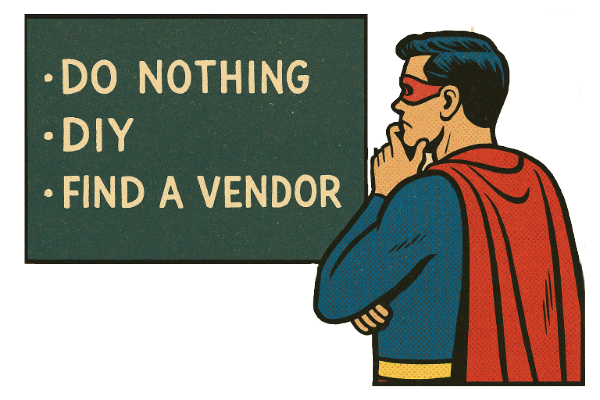What is a Supercase?
EVERY PROBLEM HAS EXACTLY THREE OPTIONS



80%+ of strategic initiatives fail to achieve their goals (HBR). Whether it was poor planning or poor execution, it costs billions. Meanwhile, "can't prove value" is the most common Closed-Lost reason after "Gone Dark". It costs hundreds of millions as sales teams bet on the wrong deals and miss their targets.
A business case is supposed to address this. But most business cases are fundamentally flawed because they're hopelessly biased. It's a billion dollar problem faced by every company in every industry.
A Supercase provides a framework to think through all the big questions. By evaluating problems through a common structure, project champions can't gloss over important details, and decision makers can compare competing priorities apples to apples. It's not a proposal. That comes later in the process.While every org should customize their templates, every Supercase should have the following major sections:
Section 1: SYMPTOMS
Symptoms are the observable signs that indicate the presence of a problem within a business. They serve as clues to identify underlying issues but are not the problems themselves.
Properly identifying symptoms guides the investigation towards understanding the root cause and ensures that any solution implemented will effectively resolve the underlying issues rather than just alleviating surface-level discomforts.
Section 2: ROOT CAUSE
Root cause analysis involves digging deeper beyond the symptoms to identify the fundamental reason for a problem. It requires asking "why" repeatedly until the true cause is uncovered so you can deliver a permanent solution.
A thorough root cause analysis positions a seller as a knowledgeable and low-risk option compared to DIY or other vendors.
Section 3: THE FIX
The Fix involves determining the best course of action to resolve a problem after understanding its root cause. It includes evaluating three options: doing nothing, fixing it yourself, or hiring a vendor.
Each option must be assessed for its costs, required resources (including people and their time), benefits, timeline and risks.
Section 4: DO NOTHING (Fix Option 1)
The main task in Do Nothing is to calcuate the cost of the problem over time. Look at 4 quarters back to make sure the cost isn't increasing or decreasing then project forward 6-8 quarters.
The advantage of Do Nothing is there's very little personal political risk, there's zero budget required and zero zero opporunity cost. The disadvantage is that the cost of the problem keeps accruing month after month.
Section 5: DIY (Fix Option 2)
The DIY approach relies on internal resources to solve the problem. This option requires a thorough understanding of the problem and the capabilities needed to address it, assessing time, effort, and costs associated with designing, implementing, and maintaining the solution.
DIY can be appealing if the organization has the necessary expertise and resources, but there's no avoiding the opportunity cost of what you couldhave done with that time it also carries risks of inefficiency and potential failure if not executed properly.
Section 6: FIND A VENDOR (Fix Option 3)
It's nearly always worth at least considering outsourcing the solution to an external expert. Vendors bring specialized knowledge and experience, potentially offering a more effective and quicker solution.
Just make sure you evaluate the vendor's credibility and capability, as well as the costs and risks involved. A vendor should be seen as a partner in solving the problem, not just a service provider, so hold them accountable to explain how the Fix could be accomplished DIY.
DON'T SKIP CHANGE MANGAGEMENT!
So many projects fail because of poor change management. And even more deals die because the Rep failed to explain how they're going to ensure adoption.
A change management plan outlines the steps necessary to implement the chosen solution effectively. It includes strategies for managing the transition, addressing resistance, and ensuring stakeholder engagement. The plan should define clear milestones, success criteria, and communication strategies to keep all parties informed and aligned.
👉 Vendors who skip this aren't earning your business.